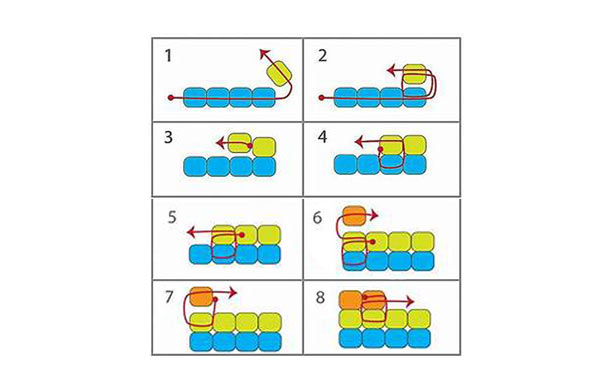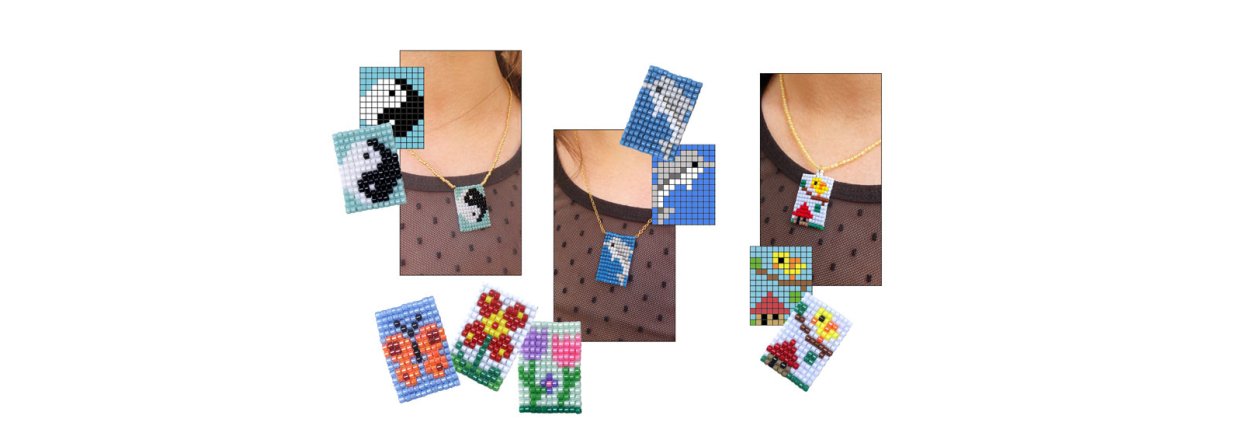In this blog post, we show you how you can use the square stitch technique to make beautiful bead icons with images and symbols, ready to hang on a necklace. The small Delica beads are perfect for making images and motifs out of beads - the theme can be varied endlessly. Write short messages, put together your favourite emoji or make cute little animal pictures with the kids.
Square stitch is a technique used in beadwork, especially to create flat and stable patterns with small beads – often seed beads. It resembles woven fabric because the beads lie neatly in rows and columns like in a grid.
Unlike in Peyote stitch (a bead technique we have presented in other blog posts), where the beads are staggered, the beads in square stitch are sewn together in a way that they sit exactly on top of each other – like small squares in a square pattern. The result is a structured and uniform look. Som vi viser i det følgende, syr man én perle ad gangen og forbinder den med den underliggende række ved hjælp af tråd, der føres gennem både den nye og tidligere perle, lidt som hvis man “væver” perlerne fast. As we show in the following, you sew on one bead at a time and fasten it to the underlying row with the help of thread that is passed through both the new bead and the previous one. It is like "weaving" the beads in place.
What is square stitch used for?
-
Jewellery: bracelets, necklaces, earrings
-
Accessories: keyrings, brooches, pendants
-
Bead weaving: images and patters made of beads
-
Imitation of bead weaving: Square stitch offers a similar result like weaving, but does not require a weave
Benefits of square stitch:
-
Provides a strong and robust result
-
Suitable for geometric patterns and text
-
You have more control than with bead weaving, because everything is sewn by hand
Download the print sheet here: Inspiration for Square Stitch Patterns.
Square Stitch

Square Stitch Necklace with Dolphin
![]()
We used the following DIY jewellery components:
Delica beads, size #11, juniper blue
Delica beads, size #11, pale grey
Delica beads, size #11, dark grey
Delica beads, size #11, pure white
Delica beads, size #11, schwarz
Approx. 1.2m FireLine, 6LB, black (or white)
40cm cable chain, gold-plated sterling silver
1 jumpring, 4mm, gold-plated sterling silver
1 spring ring clasp, gold-plated sterling silver
1 chain extender, gold-plated sterling silver
Beading needle
![]()
![]()
Start by threading a stop bead on the thread. (Choose any colour... this bead is removed again at the end.)
Sew back through the stop bead to form a loop. Tighten the thread and leave an end thread of approx. 10cm.
![]()
String 11 blue beads. This is the 1st row.
![]()
String 1 bead more and sew through bead no. 11 one more time - to form a loop.
![]()
Tighten the thread. Now the last two beads sit neatly on top of each other (se picture).
The 1st bead in the 2nd row is sewn on.
![]()
Sew through the 1st bead in the 2nd row one more time.
![]()
String a bead and sew through the second to last bead in the first row. (from bottom to top).
Tighten the thread.
![]()
Sew through the 2nd bead in the 2nd row (top to bottom). Now the 2nd bead ist fastened.
![]()
Now you are going to sew on the 3rd bead in the 2nd row: String 1 bead ... sew through the 3rd bead in the 1st row (bottom to top)...
![]()
... and sew back through the bead you have just added (top to bottom). Now you have fastened the 3rd bead.
![]()
Continue sewing the rest of the beads in the 2nd row. Follow the pattern.
![]()
Turn your piece of beading work over and start the 3rd row by sewing on the 1st bead in the same way...
![]()
Repeat ...
![]()
The 3rd row is finished - sewn according to the pattern.
![]()
Continue to sew on all the beads in the pattern in the same way. Once your are done, you sew in the lower thread end by sewing through random beads.
Remove the stop bead from the upper thread end.
![]()
Pass the upper thread end through the first link in the chain (approx. 20cm chain).
![]()
Sew through the 1st row of beads...
![]()
... and then through the last link of the chain.
![]()
After that, you sew back through 8 beads in the 1st row. Fasten the end wire by sewing through random beads.
![]()
Finally, you attach the spring ring clasp to one end of the chain. At the other end of the chain, you attach the chain extender with the help of a 4mm jumpring.
Square Stitch Necklace with Yin and Yang
![]()
We used the following components for this necklace:
Delica beads, size #11, light mint
Delica beads, size #11, pure white
Approx. 1.2m FireLine, 6LB, white
Seed beads, size #15, gold-plated
2 crimp ends, 3x6mm, gold-plated sterling silver
2 jumprings, 4mm, gold-plated sterling silver
1 lobster claw clasp, 9mm, gold-plated sterling silver
![]()
Sew the square stitch icon acording to the pattern, as described in the 1st example with the dolphin.
For this necklace, we have chosen small size #15 seed beads.
![]()
Start with a crimp end and then thread the desired number of beads onto the silk cord.
For further instructions, please see our Smyks guide DIY pearl necklace with silk thread.
![]()
Sew through the first row of beads (with the needle on the silk thread).
![]()
String seed beads on the silk thread ... until the necklace has the desired length.
![]()
You finish your necklace by fastening another crimp end and a lobster claw clasp.
Square Stitch Necklace with Bird Theme
![]()
We used the following DIY components for this necklace:
Delica beads, size #11, sky blue
Delica beads, size #11, bright yellow
Delica beads, size #11, shiny orange
Delica beads, size #11, pea green
Delica beads, size #11, apple red
Delica beads, size #11, dark cognac brown
Delica beads, size #11, matte greenish
Approx. 1.2m FireLine, 6LB, white
1 strand of cubic zirkonia beads, 2mm, faceted, yellow
2 crimp ends, 3x6mm, gold-plated sterling silver
2 jumprings, 4mm, gold-plated sterling silver
1 lobster claw clasp, 9mm, golp-plated sterling silver
![]()
Sew the square stitch icon acording to the pattern, as described in the 1st example with the dolphin.
For this necklace, we have chosen cubic zirkonia beads with a dimateter of 2mm.
First, you make a necklace in the desired length. For further instructions, please see our Smyks guide DIY pearl necklace with silk thread.
![]()
4 extra beads have been sewn on at the top of the pendant, which form a small eye.
Finally, you connect the beaded pendant with the necklace with the help of a jumpring.
Have fun :-)
Icons – symbols with many meanings
Icons play a central role in many aspects of human communication and culture. The word "icon" derives from the Greek eikon, which means "image", and icons have functioned as powerful symbols over time – both in religious, graphic and digital contexts.
Religious icons
In religious contexts, especially in Orthodox Christianity, icons are sacred images depicting saints, Jesus, the Virgin Mary or biblical scenes. They are not just considered works of art, but windows to the divine and believers use them in prayer and meditation. Their style often follows strict traditions, where colours, gestures, and perspective have symbolic significance.
Graphic and visual icons
In the world of graphics, icons are visual symbols that communicate iformation quickly and simply. Think of road signs, pictograms on public toilets or symbols on packaging. These icons are designed to be universally recognizable, regardless of language or cultural background. They are part of a visual language that makes it easier to navigate everyday life.
Digital icons
In the digital era, icons have taken on yet another meaning. On computers and smartphones, small symbols represent different functions, apps, and files. A gear often indicates settings, while an envelope symbolizes email. These icons are crucial for usability and create recognizability across platforms and systems.
Conclusion
Regardless of the context, icons act as bridge-builders between complex information and human understanding. They can be sacred, practical, aesthetic or identity-creating – and their versatility makes them an indispensable part of both past and present communication.

We will publicly show your name and comment on this website. Your email is to ensure that the author of this post can get back to you. We promise to keep your data safe and secure.